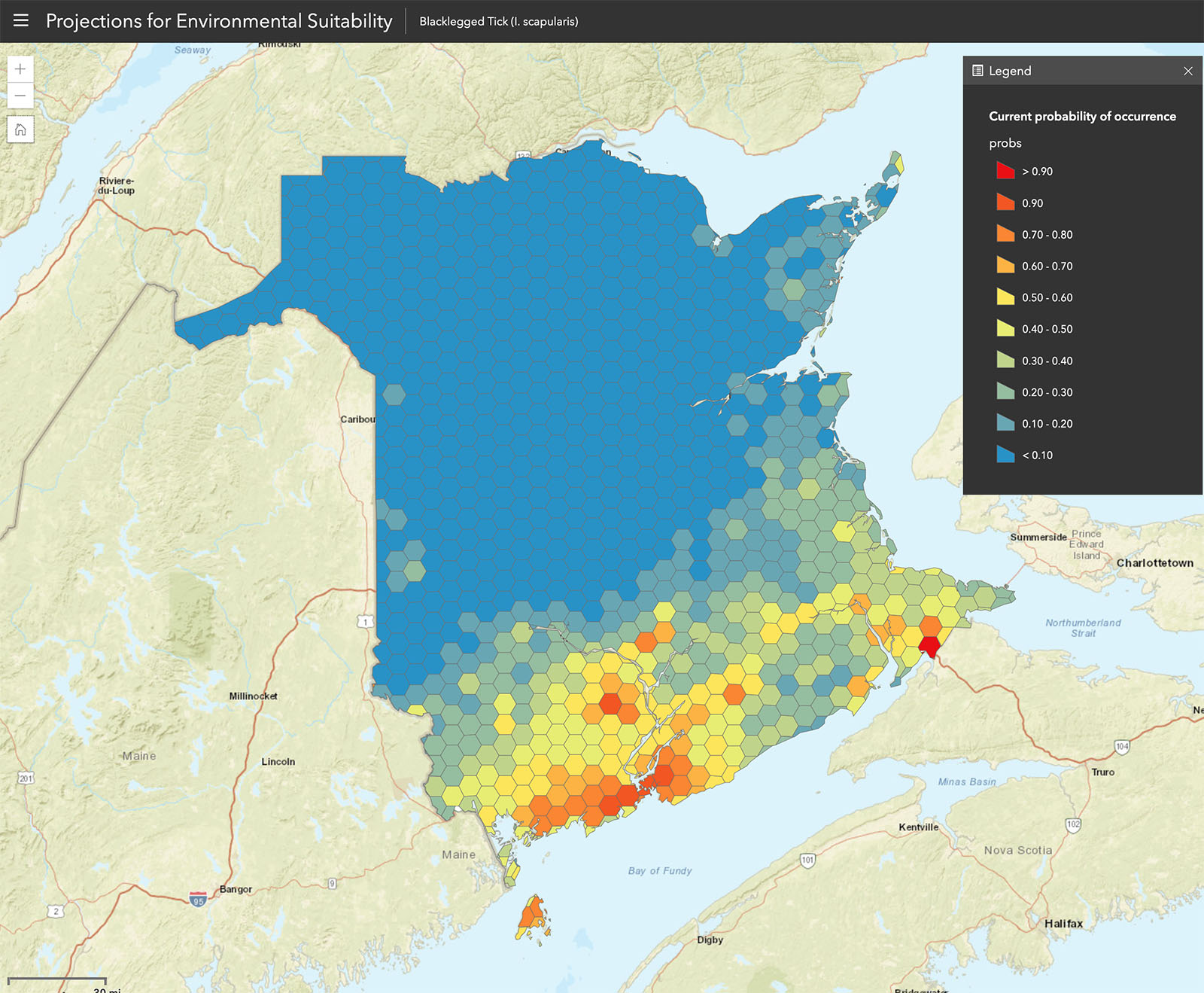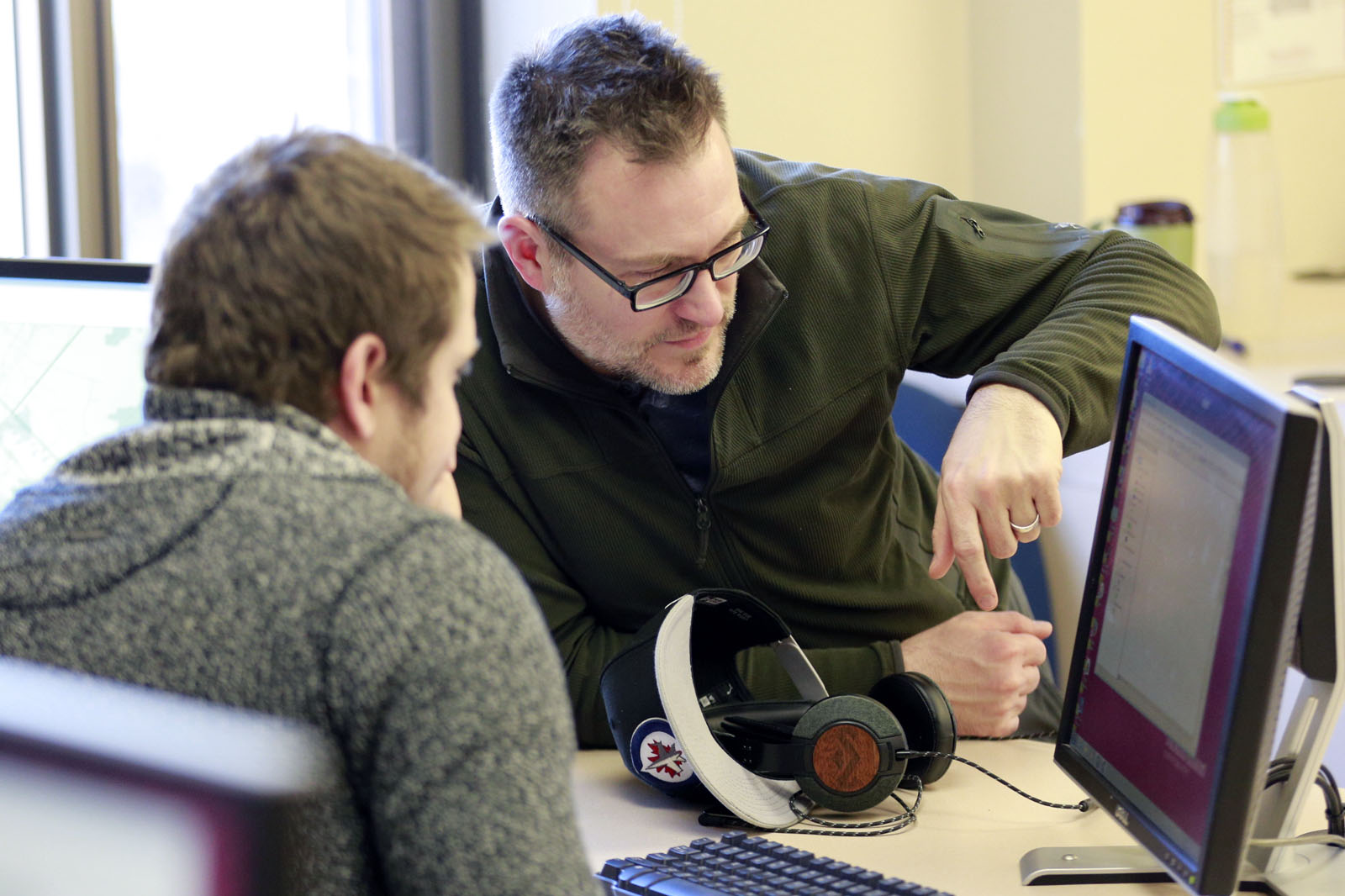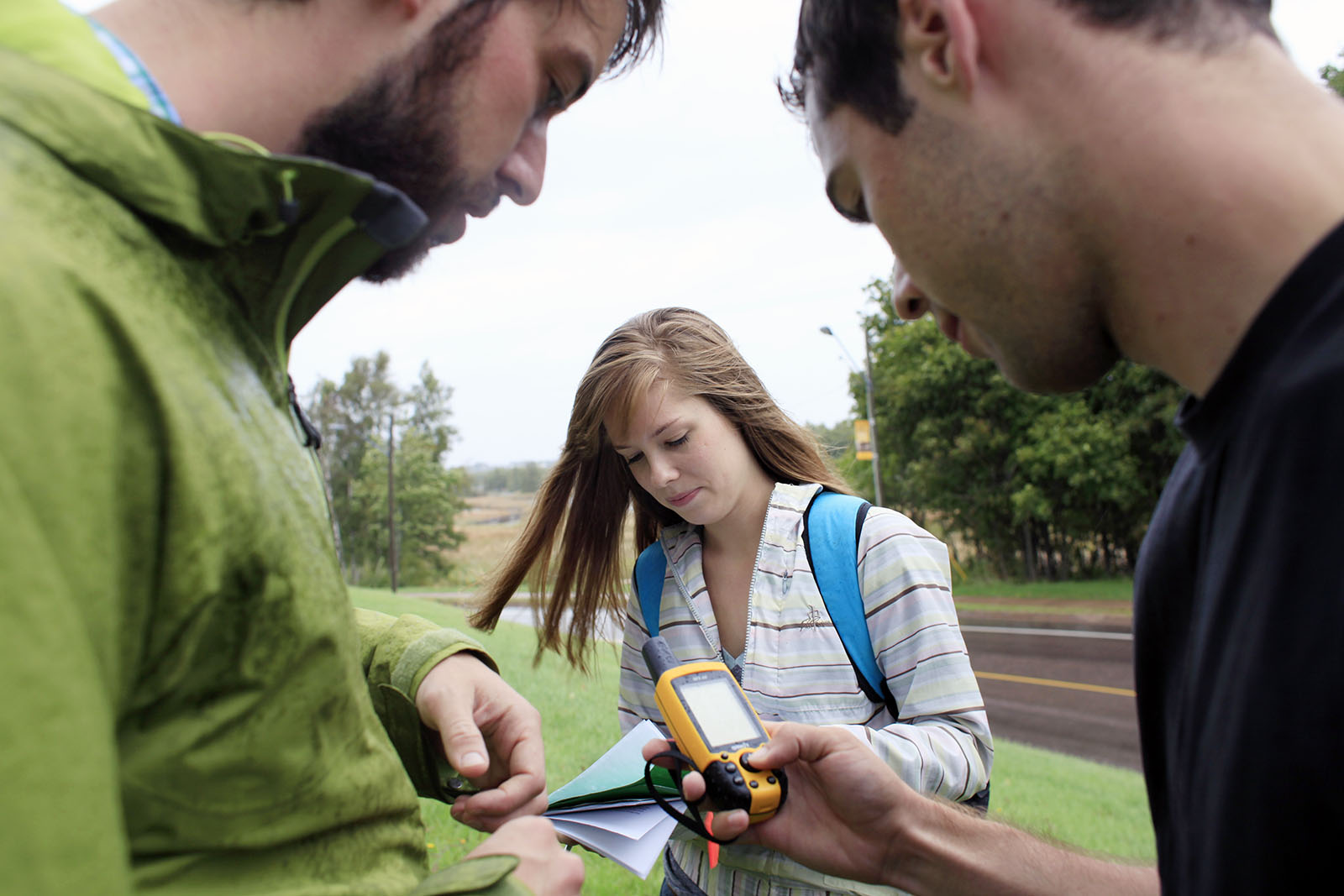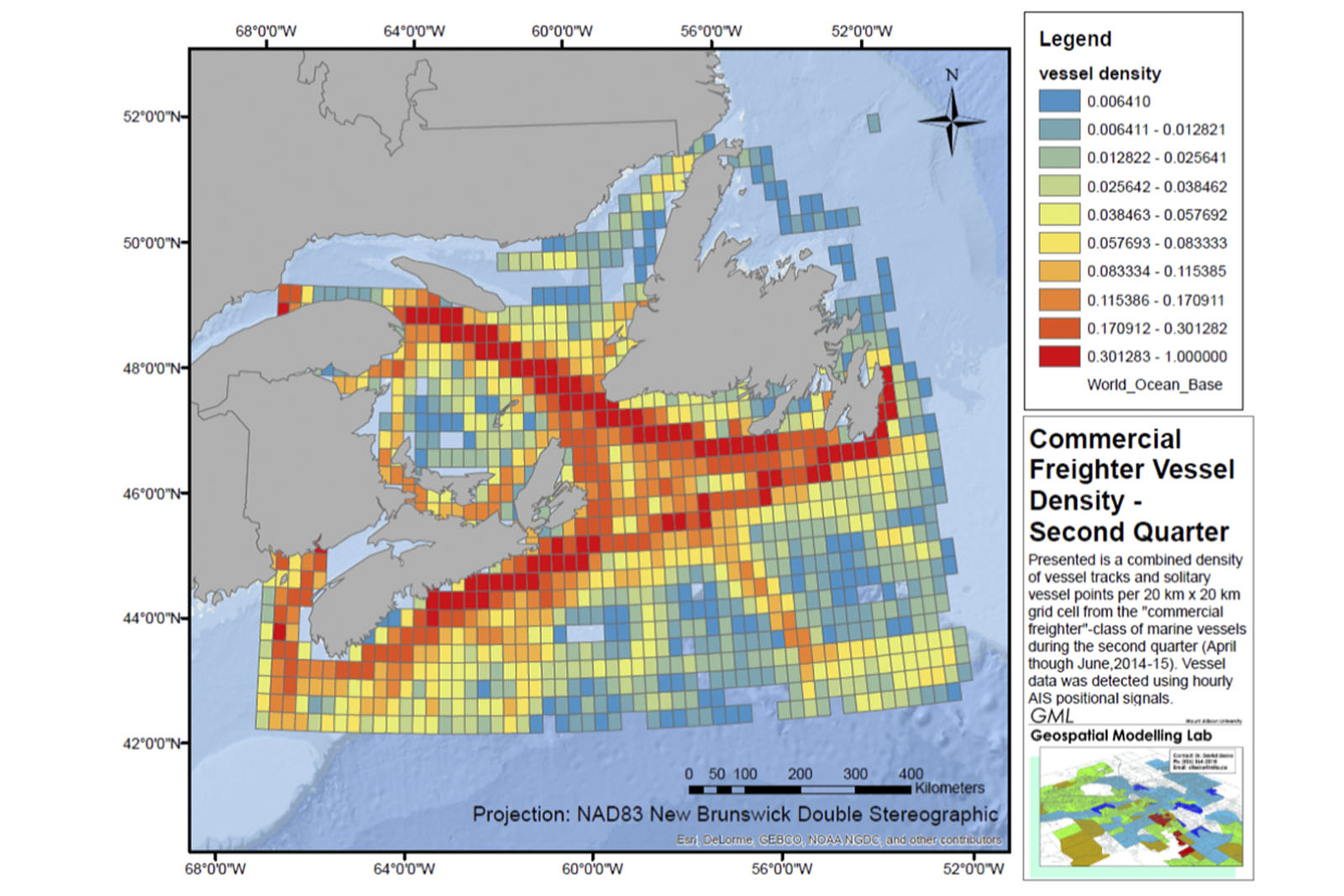Overview
GIS is computing technology that helps understand spatial patterns and relationships by analyzing spatial data and using cartography techniques to present results in a variety of formats such as tables, graphs, and maps.
GIS has a wide relevance for solving problems in a number of fields, whether it involves wildlife habitat, public health, climate change, or community land use. GIS is also widely used in social research to track patterns of social vulnerability, public opinion, human activity, or to assess access to services.
Only available as a minor.
At a Glance
Curriculum
At Mount Allison, core GIS courses are a mixture of lecture and lab where you have the opportunity to gain fluency in industry-leading software programs and GIS technology.
You'll learn the best practices of high-quality map-making, while in advanced classes you'll discover how to automate geoprocessing workflows and program GIS analyses using Python.
Combined with courses in computer science, as well as environment and geography, a GIS minor provides a valuable foundation in applied spatial analysis.
In this interdisciplinary program, you'll look at subjects like:
- data collection and analysis
- cartography
- the role of maps in conveying geographic information
- research techniques
- advanced methods of producing and visualizing surfaces and data
GIS is available as a minor only.
Not sure about the difference between a major, a minor, an honours, and a certificate?

Related programs:
GENS 2441 — Geographic Information Systems
This course surveys several aspects of traditional cartography, examines one or more Geographic Information Systems, and explores the role of maps in conveying geographic information. (Format: Lecture/Laboratory 3 Hours)
COMP 1631 — Introduction to Computer Science
This course provides a broad survey of computer science and an introduction to programming. Topics include: origins of computers, data representation and storage, Boolean algebra, digital logic gates, computer architecture, assemblers and compilers, operating systems, networks and the Internet, theories of computation, and artificial intelligence. (Format: Lecture 3 Hours, Laboratory 3 Hours)
GENV 1201 — The Human Environment
This course introduces the study of the human population and the spatial dimensions of environmental change. It examines how people interact with the environment and the core forces which shape these interactions, including population, culture, technology, and geography.
MATH 2311 — Statistics I
This course introduces some of the concepts and techniques of probability and statistics. Topics include descriptive statistics, elementary probability, probability distributions, statistical estimation, hypothesis testing, and the use of a statistical software package in analyzing data. Examples come from a wide variety of disciplines.
GENS 3401 — Research Methods in Environmental Science
This course begins with a critical examination of current research techniques. Students then design, implement, complete, and evaluate a field research project in environmental science. (Format: Lecture 3 Hours, Multi-Day Field Camp)
COMP 3851 — Computers and Society
This course examines the externalities arising from the introduction of technical innovations into society. The social context is central to understanding not only the effects of a technology but also informs the computing profession of the appropriate technical content of the innovation. An emphasis on the philosophical basis for computing ethics, including ethical issues faced by and brought about by computing professions, is the starting point for topics such as security, privacy, intellectual property, reliability and liability.
GENS 4721 — Advanced Geographic Information Systems
This course builds on the key concepts from GENS 2441 by introducing programming for automation and exploring advanced methods for producing and visualizing surfaces and data. It increases students' proficiency in the application of GIS and prepares them to conduct sophisticated spatial analyses. (Format: Lecture/Laboratory 3 Hours)
Find a full list of courses in our Academic Calendar — Geography and Environment.

Faculty Spotlight
Dr. David Lieske
Department head and associate professor, Geography and Environment
» Researchers receive Environment and Climate Change Canada funding for microplastics study
Careers
Whether you're entering the job market or continuing your education, your Mount Allison degree will stand out.
Mount Allison has been recognized by Maclean's as the top primarily undergraduate university in Canada more times than any other university.
With experiential learning and career development opportunities available in every degree, you'll also graduate with hands-on learning and real-world experience.
Our graduates also boast extraordinarily high acceptance rates to top graduate programs and professional schools such as law and medicine.
Popular career paths for GIS graduates include:
- cartographer
- GIS/GPS analyst
- field surveyor
- computer mapping and software developer
- map interpreter
- image analysis using remote sensing products
- computer programmer
- database administrator
- spatial web/application developer
- consultant
Alumni Spotlight
Laura Salisbury ('13)
BSc, Environmental Science with minors in GIS and Biology
Geospatial Standards Advisor, Natural Resources Canada
"GIS will change how you approach and solve problems, allowing you to see issues from many different angles.”

Testimonials

Studying GIS allowed me to do hands-on work in many different settings; in the computer lab I learned coding languages and data analysis while in the field I took samples and examined topics up close. Most importantly, GIS taught me how to see data distributions in the world around me, bringing the subject to life in nature, cities and stories.
Extras

Experiential learning
GIS students always spend time learning and collecting data in nature and in urban environments — including Sackville, around the Bay of Fundy, in communities throughout the Maritimes, and beyond.
GIS Lab
Our geographic information systems (GIS) computing lab provides a teaching lab and research space for faculty and students. It supports a range of GIS software used by researchers and industry.

Geospatial Modelling Lab
The Geospatial Modelling Lab (GML) facilitates spatial analysis and modelling that can be applied to assist environmental monitoring, mapping and conservation planning.
Students have the opportunity to work in this lab as research assistants, particularly those minoring in GIS.
/current-students/department-geography-and-environment
Admission Requirements
Academic Awards
Mount A is #2 in student awards
Maclean’s ranks Mount Allison second in student and faculty awards in its latest University Rankings. To date, 56 Mount Allison students have become Rhodes Scholars — one of the best per capita records in Canada.


